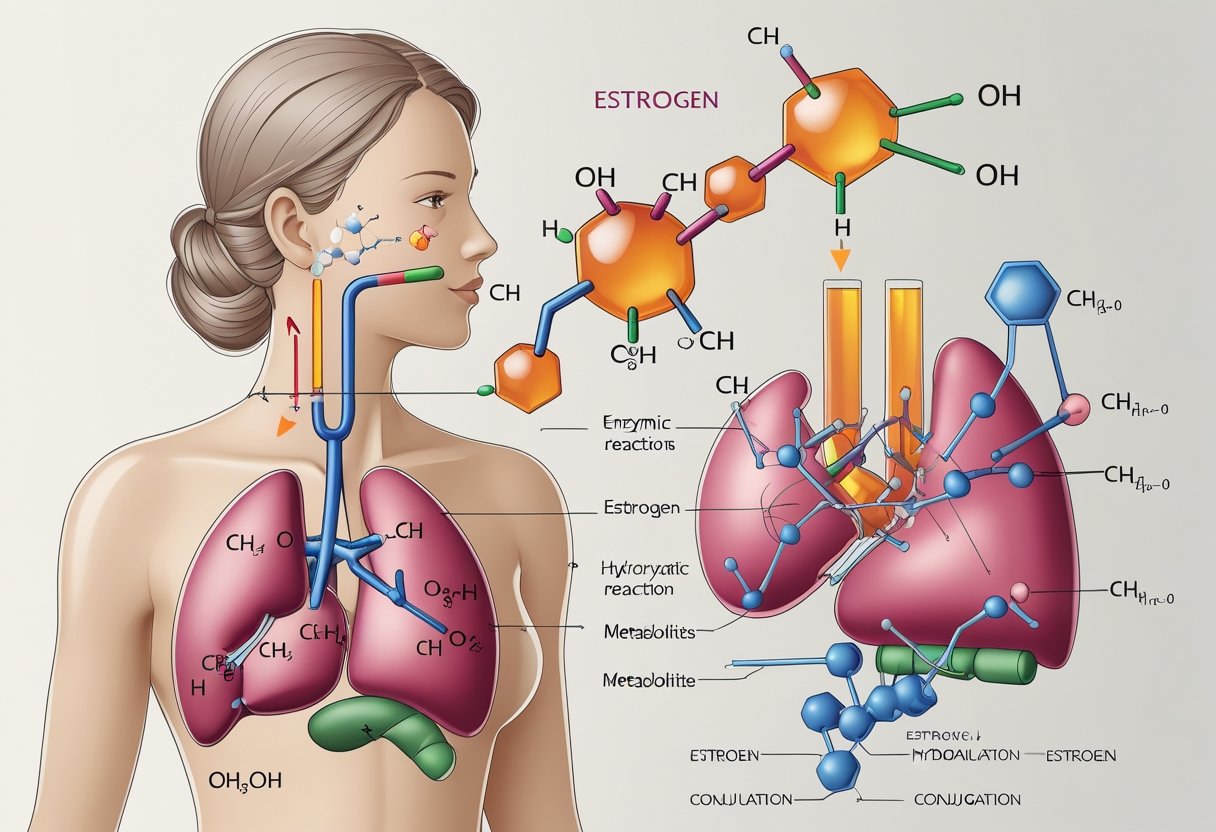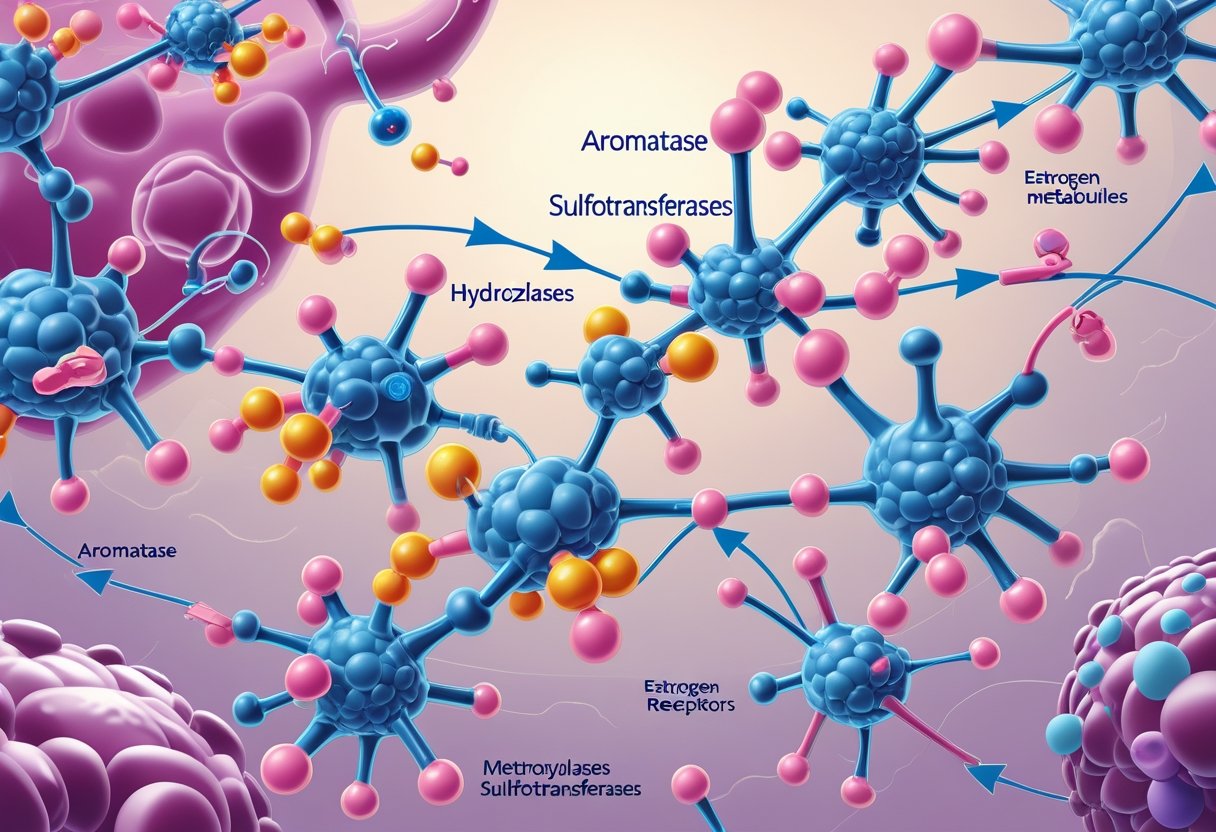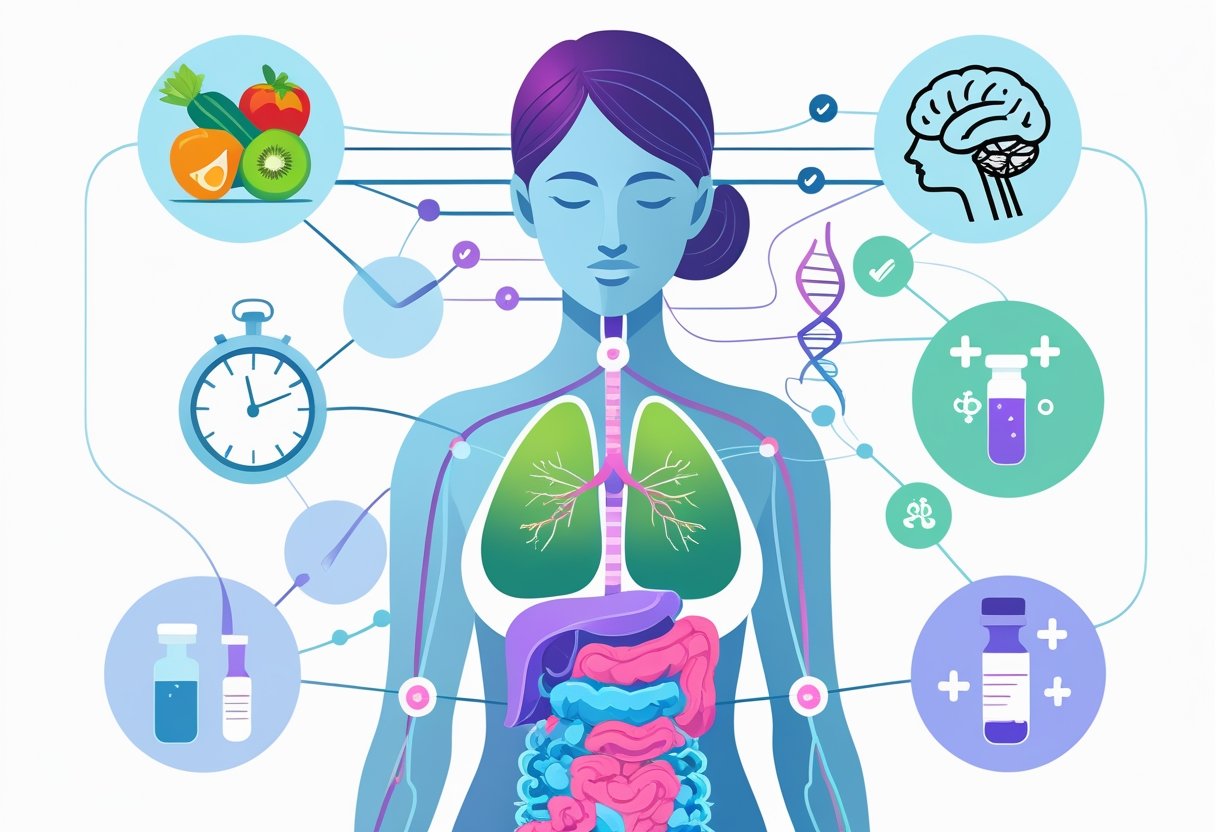Estrogen metabolism is the process where the body breaks down and removes estrogen hormones. This process mainly happens in the liver and involves turning estrogen into different forms that can be easily removed from the body. These steps are important because the way estrogen is processed can affect health, energy levels, and hormone balance.

Different forms of estrogen and their byproducts, known as metabolites, play unique roles in the body. Factors like genetics, diet, and lifestyle can impact how well estrogen is metabolized. Learning about estrogen metabolism can help people understand more about their health and the risks linked to hormone changes.
Key Takeaways
- Estrogen metabolism controls how the body processes and removes estrogen.
- Genetics, lifestyle, and diet can change how well this process works.
- Knowing about estrogen metabolism can help people make better choices for their health.
Overview of Estrogen Metabolism
Estrogen metabolism is a multi-step process that mainly happens in the liver. The pathways and hormone functions involved are crucial for managing how estrogen affects the human body.
Key Pathways of Estrogen Metabolism
The body produces three main forms of estrogen: estradiol, estrone, and estriol. These are mostly broken down in the liver by specific enzymes. One of the main enzyme systems involved is the cytochrome P-450 system. This system turns estrogen into several different metabolites through hydroxylation and other chemical reactions.
The most important pathways include 2-hydroxylation, 4-hydroxylation, and 16α-hydroxylation. Each pathway leads to the formation of different estrogen metabolites. These metabolites can have weaker or stronger effects on the body than the original estrogens.
Most estrogen metabolism happens in the liver. The products of these reactions may be excreted in urine or further processed before elimination.
Role of Hormones in Metabolic Processes
Estrogens help control many parts of metabolism in humans, such as body weight, fat distribution, and how the body processes glucose. In the brain, especially the hypothalamus, estrogens can affect both energy use and food intake.
Hormones like estradiol increase the body’s sensitivity to insulin and help regulate blood sugar levels. They also support the breakdown of fats in tissue and influence where fat is stored on the body. Research shows that estrogens regulate important metabolic features, including appetite and energy output.
Estrogen’s effects on metabolic systems explain why changes in hormone levels, such as those during menopause, can lead to weight gain and changes in fat distribution. Proper metabolism of estrogen is also important for maintaining overall hormone balance.
Types of Estrogens and Metabolites
Estrogens include several main hormones along with their many metabolites. Each type has unique actions and pathways in the body. Understanding these differences helps explain estrogen’s many roles in health.
Estradiol, Estrone, and Estriol
The three primary estrogens in humans are estradiol (E2), estrone (E1), and estriol (E3). Estradiol is the main estrogen during reproductive years and is the most potent. Estrone is less potent and becomes the most common estrogen after menopause.
Estriol is usually present in higher amounts during pregnancy. Each of these hormones is made in the ovaries, fat tissue, and, for estriol, mostly in the placenta. They can convert from one to another as needed.
| Estrogen Type | Main Source | Potency | Life Stage |
|---|---|---|---|
| Estradiol | Ovaries | High | Reproductive years |
| Estrone | Fat tissue | Moderate | Postmenopausal |
| Estriol | Placenta | Low | Pregnancy |
Estrogen Metabolites and Their Functions
After estrogens are used by the body, they are broken down or changed into various metabolites. Key metabolites include 2-hydroxyestrone (2-OH-E1), 16-hydroxyestrone (16-OH-E1), and 4-hydroxyestrone (4-OH-E1). Each one has its own biological effect.
These metabolites are produced through different pathways in the liver and other tissues. Some, like 2-hydroxyestrone, are considered less active, while others, like 16-hydroxyestrone, may have stronger estrogen-like effects in the body. These differences suggest the type of metabolite matters for health, not just the amount of estrogen. Learn more about key estrogen metabolites and how they function in the body.
Phase I and II Estrogen Metabolism
Estrogen metabolism takes place in phases. Each step uses a set of enzymes to break down or change estrogen molecules, making them safer for the body to remove. Problems in these steps may affect hormone levels and health.
Hydroxylation and 2-Hydroxyestrone
Phase I of estrogen metabolism mainly happens in the liver. This step is called hydroxylation. In this process, enzymes like cytochrome P450s add oxygen atoms to estrogen molecules such as estrone and estradiol.
One key change is the creation of 2-hydroxyestrone, which is considered a less active form of estrogen. There are other hydroxylated forms too, like 4-hydroxyestrone and 16a-hydroxyestrone, but 2-hydroxyestrone is often seen as safer because it is less likely to cause harm to DNA or cells. The balance between these metabolites can be important for health and risk levels for some conditions.
Phase I products, especially if not properly cleared, can become reactive and may damage tissues. This is why the next phase is so important for safety and removal. For more on these metabolic steps, see this estrogen metabolism overview.
Glucuronidation and Conjugation Pathways
Phase II estrogen metabolism starts once phase I products are made. The main goal is to make these metabolites water-soluble so the body can get rid of them. This stage uses several processes, with glucuronidation and conjugation being the most important.
During glucuronidation, enzymes attach glucuronic acid to the estrogen metabolites. This process is mostly handled by enzymes called UDP-glucuronosyltransferases. Conjugation can also involve sulfation and methylation, each helping to further neutralize and prepare estrogen for removal in urine or bile.
Efficient conjugation is vital. If phase II does not work well, reactive estrogen products can build up. This may increase the risk of problems with DNA or tissue health. Good phase II metabolism is linked to lower estrogen-related health risks and better hormone balance. More details on these detox pathways can be found in this resource from DUTCH Test.
Enzymes and Receptors in Estrogen Metabolism

Estrogen metabolism depends on specific enzymes and receptors found in tissues such as the breast, uterus, and brain. These molecules help control how estrogen is made, activated, broken down, and how it acts on cells.
Steroid Sulfatase (STS) and Its Mechanisms
Steroid sulfatase (STS) is an enzyme that removes sulfate groups from estrogen sulfates, turning them into active estrogens. This enzyme is important because it increases the availability of estrogens in tissues. High STS activity is seen in tissues like the mammary gland and prostate, influencing the levels of active estrogen locally.
The presence of STS in target tissues allows cells to control their own estrogen supply by converting circulating inactive estrogen sulfates into active forms. This process is key for normal growth and development, as well as conditions like cancer. Other enzymes, such as cytochrome P450, also take part by metabolizing estrogens into various byproducts, affecting how long estrogen stays active in the tissue. For more details on enzyme roles, see the expression of enzymes involved in estrogen metabolism in human tissues.
Estrogen Receptor Interactions
Estrogen receptors are proteins found inside cells, mainly known as ER-alpha and ER-beta. These receptors bind to estrogen, letting the hormone send signals that can change how genes are expressed. When estrogen attaches to a receptor, it can turn genes on or off, leading to effects like cell growth or other changes.
The amount and type of estrogen receptors in a tissue affect how that tissue responds to estrogen. Both the receptors and enzymes like aromatase and STS work together to control estrogen action in a very localized way. This helps explain why estrogen has different effects in different parts of the body. More information about these processes can be found in Estrogen receptors and estrogen-metabolizing enzymes in human tissues.
Factors Influencing Estrogen Metabolism

Estrogen metabolism is shaped by several important factors that can affect hormone levels and activity in the body. These factors include genetic makeup, the activity of other hormones, and body weight.
Genetics and Hormonal Balance
A person’s genes play a major role in how their body processes estrogen. Certain genetic variations affect enzymes that break down estrogen, which means some people clear estrogen faster or slower than others.
Hormonal balance is also important. If there are problems with the production or balance of hormones like thyroid, cortisol, or insulin, it can shift estrogen metabolism. For example, thyroid disorders can slow down metabolism and change how much estrogen is active in the blood. Some rare genetic changes can make people more likely to build up harmful estrogen byproducts.
Imbalances can sometimes cause symptoms of too much or too little estrogen even if total hormone production is normal.
Role of Progesterone
Progesterone acts as a natural partner to estrogen in the body. When estrogen and progesterone are in balance, estrogen works as it should and is processed normally.
If progesterone levels drop, estrogen can have a stronger effect, which may lead to symptoms like mood swings or heavy periods. Low progesterone also changes how the liver processes estrogen, sometimes creating more active or harmful forms.
Maintaining a steady level of progesterone, especially during the menstrual cycle, helps prevent estrogen dominance. Lifestyle factors that support healthy progesterone include getting enough sleep, managing stress, and not over-exercising. In some cases, doctors may use progesterone supplements to restore balance.
Obesity and Adiposity
Obesity is closely linked to higher estrogen levels. Fat tissue can make estrogen from other hormones using an enzyme called aromatase. This means people with more body fat tend to have higher estrogen, even after menopause.
Extra fat, especially around the belly, can also slow down the body's ability to clear out old estrogen. This buildup may raise the risk for some hormone-related conditions. Research shows that diet, physical activity, and body size have a noticeable impact on how the body produces and breaks down estrogen, especially in postmenopausal women. Read more about these effects at estrogen metabolism and obesity and how body size and lifestyle influence estrogen.
Dietary & Lifestyle Impacts on Estrogen Metabolism
Diet and lifestyle choices have clear effects on how the body processes and regulates estrogen. Certain foods and daily habits can change estrogen levels, forms, and even how fast it gets excreted.
Dietary Influences: Fiber and Cruciferous Vegetables
Eating fiber supports healthy estrogen metabolism. High fiber diets help the body remove estrogen through digestion, so estrogen spends less time being reabsorbed.
Vegetarian diets can lead to a marked increase in estrogen excretion and often result in lower blood estrogen levels. For example, plant-based diets with plenty of fiber and vegetables, especially cruciferous types like broccoli and Brussels sprouts, have been linked to lower estrogen activity and better estrogen balance according to VA.gov.
Cruciferous vegetables provide compounds, like indole-3-carbinol, which may help the body break down estrogen into less active forms. Diets based on Mediterranean eating patterns—rich in vegetables, fruits, legumes, whole grains, and healthy fats—are also connected with more stable estrogen levels, as noted by Healthline.
Physical Activity Effects
Regular physical activity influences both estrogen metabolism and levels in the body. Exercise can help lower total estrogen by reducing body fat, which is a source of estrogen, and by promoting hormone balance.
Studies have shown that combining exercise with healthy eating habits leads to greater control of estrogen forms in the body, helping shift the balance toward less harmful types, as highlighted in findings published on PMC.
Activities such as brisk walking, cycling, or team sports, when done regularly, can support overall hormone health. For adults, aiming for at least 150 minutes of moderate exercise each week is recommended for best results. Regular activity also aids in healthy weight maintenance, which is important since excess weight often leads to higher estrogen levels.
Estrogen Metabolism in Women
Estrogen aids in many body functions for women, including reproductive health, bone strength, and heart health. The way the body handles estrogen, called metabolism, depends on factors like age, hormonal status, and overall health.
Differences in Premenopausal Women
Premenopausal women make most of their estrogen in the ovaries. This hormone level is usually higher and more stable than in older women. Because estrogen is high, it helps keep periods regular and supports bone and heart health.
In premenopausal women, estrogen also affects how the body uses glucose and stores fat. High estrogen levels can boost insulin sensitivity, which helps control blood sugar. These effects are important for weight and energy balance. Estrogen can also influence where fat is stored, often leading to more fat around the hips and thighs compared to the abdomen as seen in men. For more details, read about how estrogens regulate key features of metabolism and their impact on women's health.
Estrogen Metabolism and Disease Risk
Estrogen metabolism is closely related to the risk of developing several diseases. Changes in how the body processes estrogen can lead to health problems, especially in women as they age.
Links to Breast Cancer
The way estrogen is broken down in the body affects the chances of getting breast cancer. Some forms of estrogen metabolites are less harmful, but others may increase cell growth in breast tissue, which can raise cancer risk. Research has shown that one metabolic pathway, called oxidative metabolism, may create estrogen byproducts that damage DNA.
Differences in estrogen metabolism have been linked to a higher chance of breast cancer, especially in women after menopause. Proper estrogen balance helps protect against cancer, while imbalances make breast tissue more sensitive to harmful changes. Studies suggest that estrogen metabolism is linked with breast cancer risk.
Frequently Asked Questions
Estrogen metabolism is linked to many physical symptoms and health risks. The process involves the liver, hormones, diet, and can be affected differently in both men and women.
What are the signs of imbalanced estrogen metabolism?
Common signs include irregular periods, mood swings, weight gain, or breast tenderness in women. Men may notice gynecomastia or changes in mood. Imbalance can also cause sleep problems and headaches.
How does estrogen metabolism impact breast cancer risk?
Some estrogen breakdown products can damage DNA, which may raise cancer risk. A small portion of estrogen is changed into a type called 4-hydroxyestrone, which can promote cancer by damaging DNA.
What is the role of the liver in estrogen metabolism?
The liver changes estrogen hormones into different forms that are easier to remove from the body. Most estrogen is processed in the liver where it is made less active and then sent out in urine or stool. Problems with liver function can slow this process down.
Can diet influence estrogen metabolism, and how?
Eating cruciferous vegetables like broccoli, cabbage, and kale can support healthy estrogen breakdown. Antioxidants in vegetables help remove harmful metabolites. Choosing organic foods and avoiding pesticides may also support estrogen metabolism.
What differences exist in estrogen metabolism between men and women?
Women usually have higher estrogen levels and a faster estrogen cycle because of menstrual and reproductive needs. Men metabolize smaller amounts of estrogen, mainly from the conversion of testosterone. Both genders use the same pathways, but the hormone amounts and effects can be different.
What effects do supplements have on estrogen metabolism?
Some supplements claim to help the body process estrogen better. For example, certain plant extracts or vitamins might support liver function or hormone balance. It is important to talk to a healthcare provider before using any supplement for hormone health.
Conclusion
Estrogen metabolism is a key part of hormone balance in the body. The liver plays a central role in breaking down and excreting estrogens. This process helps control the amount and type of estrogens in the blood.
Several tissues, including fat and muscle, are affected by changes in estrogen metabolism. When these tissues do not respond well to estrogen, it can lead to problems like metabolic syndrome, obesity, or type 2 diabetes. In some cases, problems in estrogen breakdown may be linked to a higher risk of certain cancers, such as breast cancer.
The following table outlines important factors related to estrogen metabolism:
| Factor | Impact |
|---|---|
| Liver function | Main site for estrogen breakdown |
| Tissue sensitivity | Affects energy balance, glucose levels |
| Breast cancer risk | Metabolism changes can increase risk |
| Obesity | Can result from metabolic dysfunction |
Understanding how the body processes estrogens is important for health. Changes in these pathways can affect energy, weight, and cancer risk. To learn more, see this overview of estrogen metabolism.

